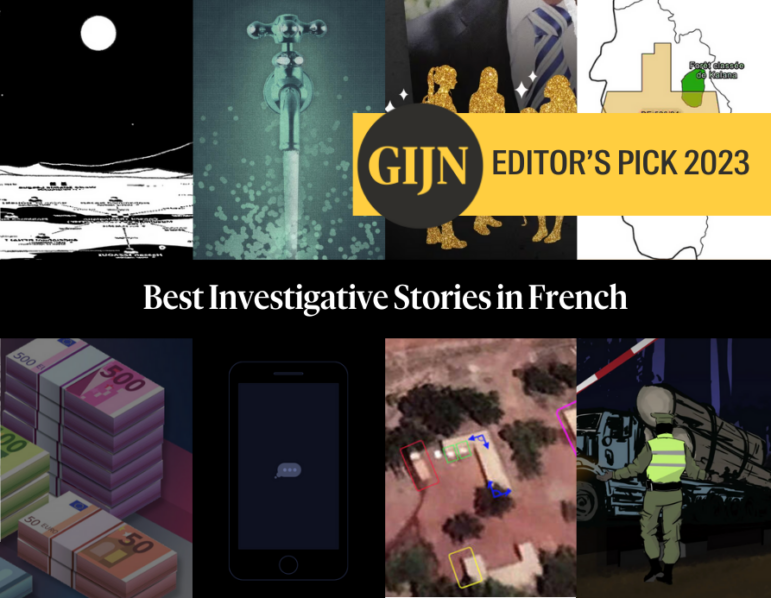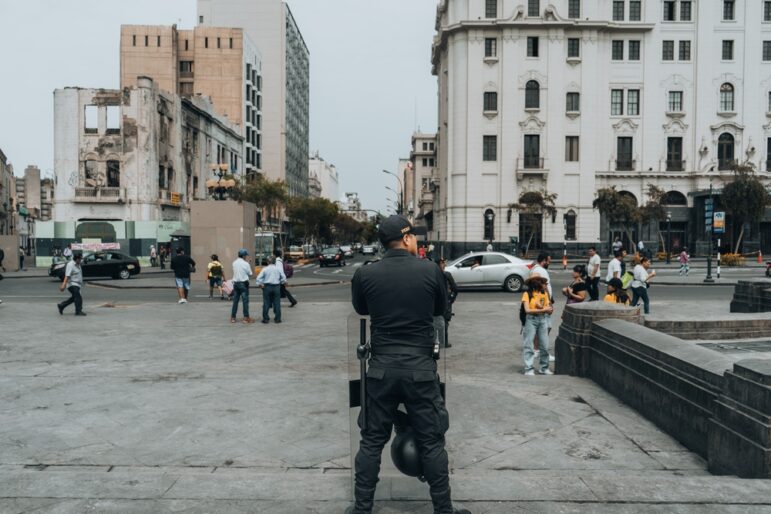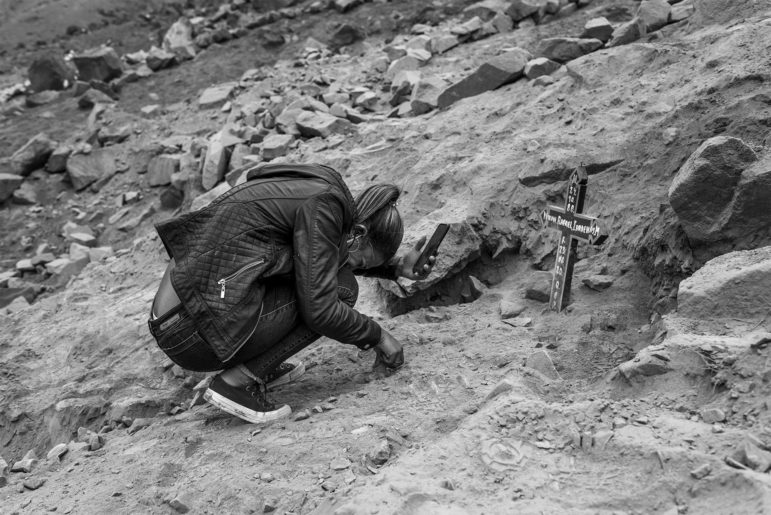

Una mujer sobrepasada por las emociones mientras intenta transmitir un funeral para sus parientes que no pudieron atender debido a la pandemia. Foto: Omar Lucas
How Leading Photojournalists Around the World Are Documenting COVID-19
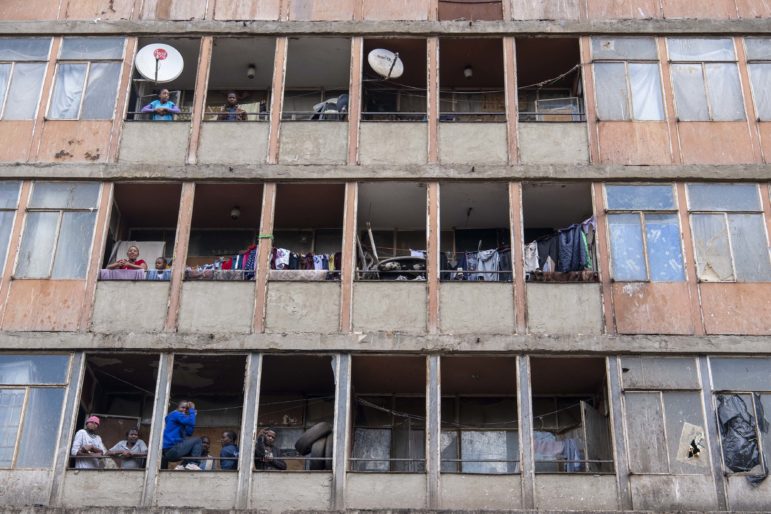
Residents in Johannesburg’s high-density Hillbrow district seek social relief during South Africa’s strict “level 5” lockdown by congregating on balconies and rooftops. Photo: Madelene Cronjé
In interviews with GIJN, six leading photojournalists from around the world describe different approaches to the safety, access, and technical challenges of shooting the pandemic.
In May, photojournalist David Goldman watched the news in disbelief as deaths from the coronavirus climbed out of control at a state-run veterans care facility in the north east of the United States.
In what would become both a national tragedy and a state scandal — with 100 deaths there since the start of the pandemic – veterans at the Massachusetts Holyoke Soldiers’ Home who had served the US in wars going back to World War II were falling to COVID-19, while their quarantined families could only ask nurses about their final moments.
According to a later independent investigation, an order to combine infected and non-infected residents in the same ward was just one of many mistakes made at the facility that contributed to the disaster.
Refused both access and cooperation from facility administrators, Goldman — a member of the Associated Press’s enterprise photography team — combed obituaries for references to the home and the coronavirus, and sought out relatives on Facebook.
When he eventually found some of the grieving family members, he couldn’t approach them due to social distancing safety rules.
So Goldman proposed a photographic plan to them that he’d never seen done before, and which he wasn’t sure would work: that he would somehow project huge images of their loved ones onto the outside of their family homes, and photograph those murals with family members standing at the windows.
The plan brought other problems. How would the families’ faces be lit? How would he power a projector from the street when he could not even enter family homes to plug in a cable?
In an interview with GIJN, Goldman admits that he had no idea about any of these solutions at the outset, and that he worried that he might risk deepening the anguish of the families involved. But his project with a dozen bereaved veterans’ families would emerge as one of the most memorable, and dignifying, portraits of the pandemic in the US.
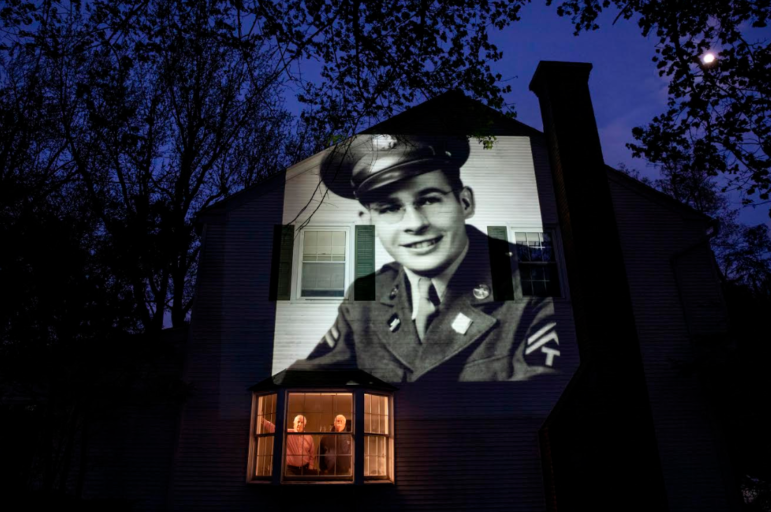
An image of James Sullivan — a World War II veteran lost to the COVID-19 pandemic — is projected onto the home of his son Tom Sullivan, (left), standing with his brother Joseph Sullivan. Image: AP Photo/ David Goldman
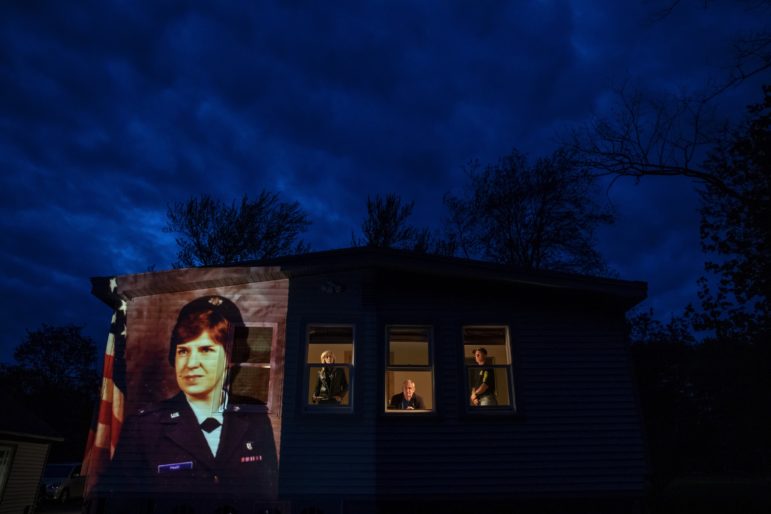
An image of U.S. Air Force nurse Constance “Kandy” Pinard — who died from the coronavirus at age 73 — is projected onto her childhood home. Her sister Tammy Petrowicz (left), and brothers Paul and Brian Driscoll stand at the windows. Image: AP Photo/ David Goldman
Around the world, photojournalists have had to find innovative strategies both to keep their subjects safe from catching the coronavirus, and to access and document a pandemic during a global lockdown.
Their images are also having impact. In Indonesia — where the coronavirus pandemic has been downplayed by a slow-moving government — photojournalist Joshua Irwandi triggered a new public conversation about its urgent dangers with an image of a COVID-19 victim’s body fully wrapped by hospital staff to prevent infection. The image has been used in the cover story for National Geographic’s August issue. In a post about the scene that attracted 347,000 “likes,” Irwandi noted the heroism of nursing staff on Instagram, and that “I only thought what happened to this person may well happen to people I love, people we all love.” Reflecting the profound loneliness associated with the pandemic, the image also attracted more than a million likes on the Nat Geo Instagram site within a day.
http://www.instagram.com/p/CC6x9CHB4KU/
Working with Investigative Reporters
In Peru, independent photographer Omar Lucas worked with investigative reporters at GIJN member newsroom IDL – Reporteros, who were seeking to prove that the government’s reported coronavirus death counts were far below the true toll.
His images helped to make that case, after he embedded with private crematoria crews as they collected bodies from homes. Wearing personal protective equipment (PPE), Lucas ensured he maintained a 6-foot radius around his body, even as he moved through alleyways.
“There were multiple challenges, but the main one was to leave the fear behind me and be able to enter into the places where the bodies were,” said Lucas, speaking to GIJN in Spanish, via a translator. “It wasn’t easy, in some cases we had to wait a while until the exact [right] moment to take the photos. While accompanying them, I had to wear the same protective suit they used, a good mask, and alcohol for regular disinfection. The technical decision was to carry light equipment [and to be] always ready.
“Working with investigative journalists is done in a more exhaustive way, without missing a single detail,” he said. “I think the difference is that with them you can access spaces that are not always open to the media.”
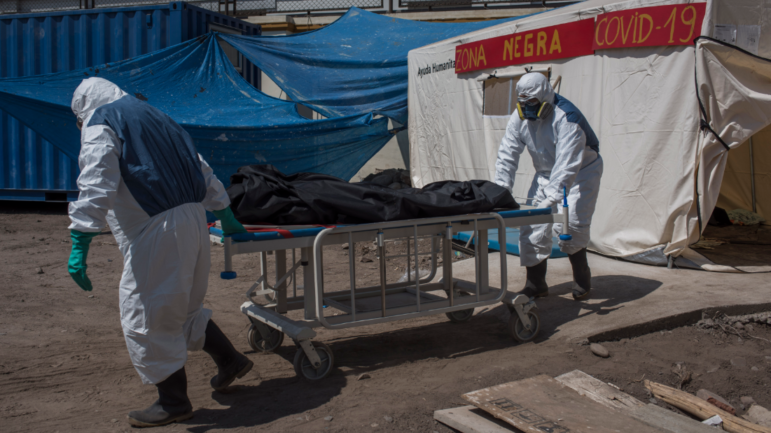
Workers for a crematorium subcontracted by a local health department collect bodies in Lima. Photo: Omar Lucas / Courtesy IDL-Reporteros
Lucas has spent many weeks since then documenting the impact of the coronavirus in some of the poorest neighborhoods in the capital city, Lima.
“Aside from the mask for protection and to maintain a safe, prudent distance, I did my work as I always do — creating an emotional and empathetic relationship with people so I can earn their trust, enter their lives, and be able to portray them,” he said. “I go as light as possible, with my camera and a 35mm lens.”
He spent several days in the Belaúnde cemetery in the Comas district, north of Lima. Here, Lucas secured an invitation from family and friends of a Venezuelan victim of COVID-19 to attend the burial.
“They decided to open the coffin to see if it was their family member who was inside, but when they opened it the body was bagged and…sealed,” he recalls. “The girlfriend of the deceased approached it and began to cry, totally torn, looking at the sky. It was a really painful moment.”
Lucas took another image when the dead man’s cousin tried to livestream the burial for the man’s absent parents. Doubled over with emotion, that cousin was unable to continue the broadcast. “I lowered the camera for a while,” said Lucas.

Mourners at a Lima cemetery react as they discover that their deceased relative has been covered in protective plastic due to local COVID-19 rules. Photo: Omar Lucas

A woman is overcome with emotion as she tries to livestream a funeral for relatives who were unable to attend due to the pandemic. Photo: Omar Lucas
Lucas decided to produce a photographic series on the impact of coronavirus on the Venezuelan community in Peru.
“They were affected in a drastic way,” he says. “Eighty percent of them worked informally before the arrival of COVID-19 and the quarantine decreed by the government left them without daily income for their subsistence, so the vast majority could not pay the rent and were evicted. Many of them, right now, are returning to their country by foot.”
He documented life for 34 Venezuelans at one shelter in Lima. And he captured compelling moments on the street, like two Peruvian women recognizing the plight of a young Venezuelan mother, Mariela del Valle, who had been laid off from her job at a local shopping center due to coronavirus business closures. The Peruvians led Del Valle to the Santa Rosa church in downtown Lima, where Lucas captured the image of the women using a blanket to catch food dropped by a nun from a second story window.
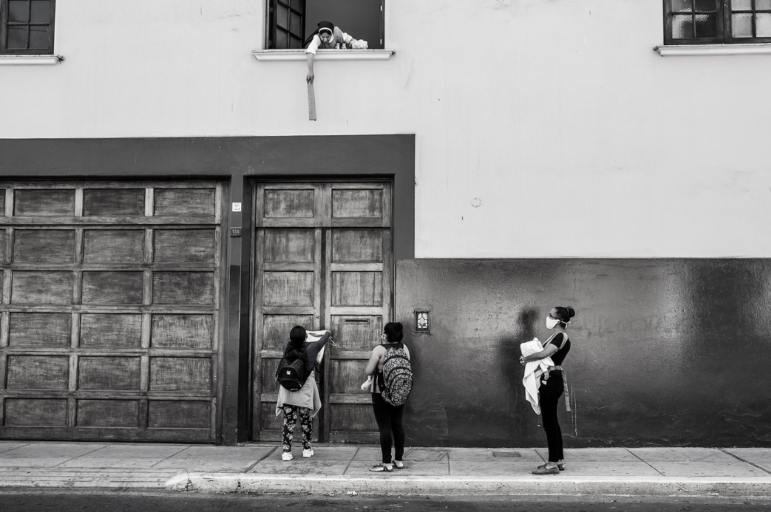
Venezuelan mother Mariela del Valle (far right) watches as a nun in Lima drops food from a second story window. Photo: Omar Lucas

Marilin Muro, 47, moved to the Sin Fronteras shelter with 33 fellow Venezuelans, after economic impacts of the coronavirus ended her employment with a textiles company. Photo: Omar Lucas
Photographing from Home
In Paris, Thomas Dworzak — a former war photographer, and winner of a World Press Photo award — decided to abandon in-person photography of the pandemic altogether, after a few fruitless days trying to capture the unfolding crisis on his bicycle.
Seeing himself as high risk for illness or transmission, he decided to take screenshots and photographs of lockdown meetings carried out on the video platform Zoom around the world through his laptop — including some where he’d ask a nurse or caregiver to point their laptop in one direction and let it run for hours.
If investigative reporters could gather key information via the telephone, Dworzak thought, why couldn’t a photographer find a way to gather compelling visuals via the computer?
“Very early on in the crisis, I decided to turn my look inside,” he says. “I thought, because everyone is in lockdown, there’s this whole world opening up, and it’s opening up in Zoom. For the first time, I couldn’t go [to scenes] not because people don’t want to give me access or I’m blocked by a police cordon, but because I might endanger people. Obviously, stills from Zoom are not that good visually; it’s a little flat. But it can be very interesting.”
Dworzak — the outgoing president of Magnum Photos — says he sat through almost a thousand Zoom meetings during the pandemic. He has not yet published the project. But during one virtual memorial for George Floyd — the African-American man whose death at the hands of a Minnesota police officer was captured on video — Dworzak noticed flames in one of the tiny galley boxes on the screen. When he enlarged it, he realized that a “Zoom bomber” had invaded the memorial with racist images of a Ku Klux Klan cross burning, and captured the mourners reaction, before the bomber was ejected from the meeting.
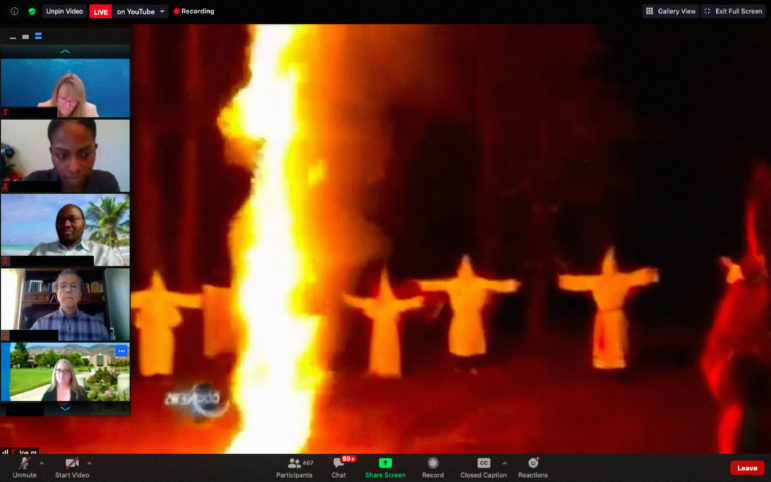
A virtual memorial for George Floyd is infiltrated with racist images from a Ku Klux Klan cross burning. Photo: Thomas Dworzak/ Magnum Photos
Dworzak found open meetings via Twitter search, or secured invitations to join private meetings. He also sometimes won the cooperation of officials at institutions in Israel, New Zealand, Gabon, and France to leave their laptop cameras open for hours.
“I shot an amazing religious service in Gabon just last night — it was beautiful,” he says. “[Another] one was a home for the elderly in France. I would set up a Zoom call with the woman who ran the place, and asked her to put her laptop in the middle of the community room where they had their dinner and let it run for a couple of hours. And sometimes move it around. It was all atmospheric level; it was not deep-insight photojournalism. But I kind of like this cinematic way of life unfolding.”
Dworzak would simply hit Command-Shift-3 on his Apple keyboard to capture compelling moments, or just everyday life in the lockdown.
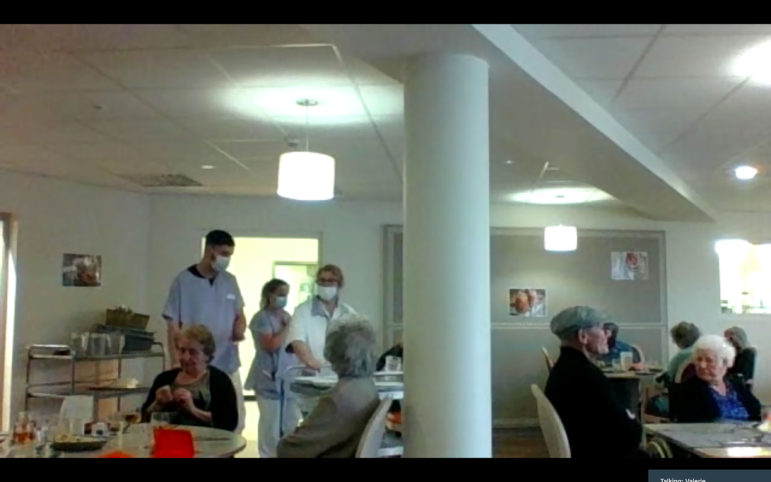
A screenshot captures the “new normal” of daily life for residents and staff at a French nursing home. Photo: Thomas Dworzak/ Magnum Photos
Dworzak even turned to video games to capture the personas of Hong Kong pro-democracy protesters inside the interactive “Animal Crossing” video game by Nintendo.
Taking on the persona of one of the virtual animals in the game and using a translator, the photographer says that as a novice gamer he initially bumped his avatar into trees and buildings, but that activists represented by other virtual animals eventually came to accept him. Dworzak grabbed screenshots of the protest symbolism for his as-yet unpublished lockdown series.
“I actually met a Hong Kong protest leader, where both of us were teddy bears,” he says. “This was the weirdest thing I’ve ever done. But they showed off their protest movement within the game. I got images of teddy bears chopping up images of Chinese politicians. it’s actually an important [platform] and the Chinese government has banned it.”
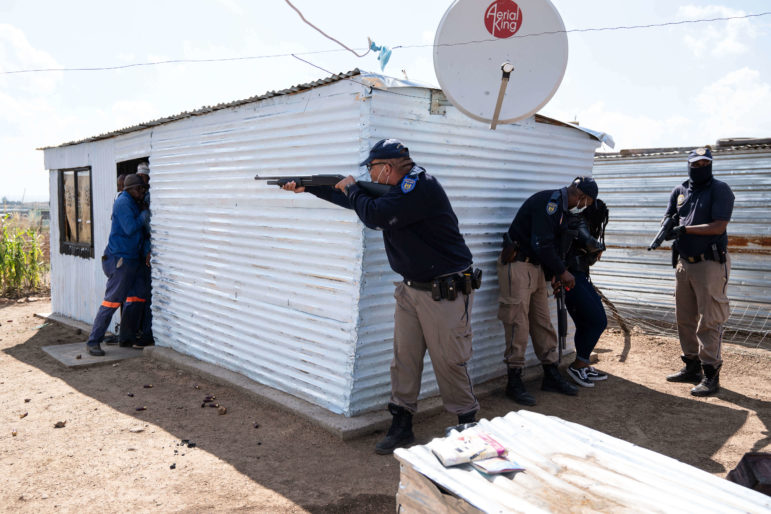
Johannesburg Metro Police officers fire rubber bullets at residents resisting eviction at the Lakeview informal settlement, south of Johannesburg. The raid happened despite a government moratorium on evictions during South Africa’s COVID-19 lockdown. Photo: James Oatway
Shooting Violence and the COVID-19 Outbreak
In South Africa, photographer James Oatway essentially uses a war photographer’s approach to covering violence linked to the pandemic, often wearing body armor and a prominent “PRESS” insignia, and making tactical decisions daily.
Oatway has captured police and security force brutality during the lockdown in photo essays like this one for New Frame, which helped to prove that police were enforcing evictions despite a government moratorium on evictions during the COVID-19 lockdown.
“My approach is flexible — you might call it a blended news and documentary planning approach,” says Oatway. “Sometimes I’ll respond to a tip-off coming in, sometimes I’ll hook up with NGOs, sometimes I go patrolling around and observing, and you bump into some cops shooting rubber bullets at people. I wore a bulletproof vest with ‘PRESS’ on it, because I wanted to make sure I was easily identifiable as press, and we didn’t know how strict the cops were going to be. It gave them less opportunity to give me shit. A little bit of luck and a little bit of preparation with sources also helped.”
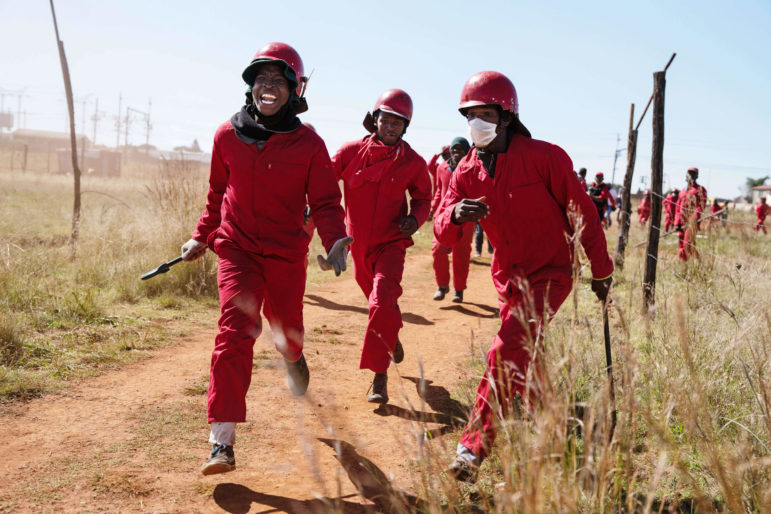
Security officers with the Red Ants, referred to as a “security, relocation, and eviction services company” on its website, charge residents at an informal settlement near Johannesburg. Photo: James Oatway
Immersing with the Community
Photographer Madelene Cronjé, who also works in Johannesburg, found that the lockdown forced her to think differently about the subjects to shoot, and even about the ethics of providing humanitarian help as a journalist.
A senior photographer with New Frame, Cronjé says coverage of the pandemic began with confusion for many South African photographers, with police — and even journalists themselves — often unsure of whether news photographers and reporters had been designated as essential workers, exempt from travel and curfew restrictions.
“During our level 5 lockdown [South Africa’s strictest quarantine], the police brutality was at its worst, enforcing those evictions and curfews,” she says . “It was hard for a lot of people to follow the rules at the beginning, and police were targeting high density areas, and they were really treating people badly. There were beatings and deaths.”
Cronjé says thinking about her personal home quarantine experience helped her to formulate strategies for capturing how fellow citizens were coping.
“It forced you to think of images differently — it forced you to look through windows and doorways, and think of what comes with isolation,” she says. “We asked: Should we actually be shooting? It was important to show what was going on, but you also didn’t want to be putting people in danger by going out. You had a fight with yourself: Am I pushing it? If not, am I being responsible, or am I being lazy?”
Living in an apartment building in Johannesburg, Cronjé realized that the children of domestic workers at the building were effectively trapped by the lockdown to daytime lives in a small concrete courtyard. So she documented how these children living in the servants’ quarters — who were unable to attend school, or return to their family homes — were forced to play, socialize, and do their homework on that barren concrete strip for months.
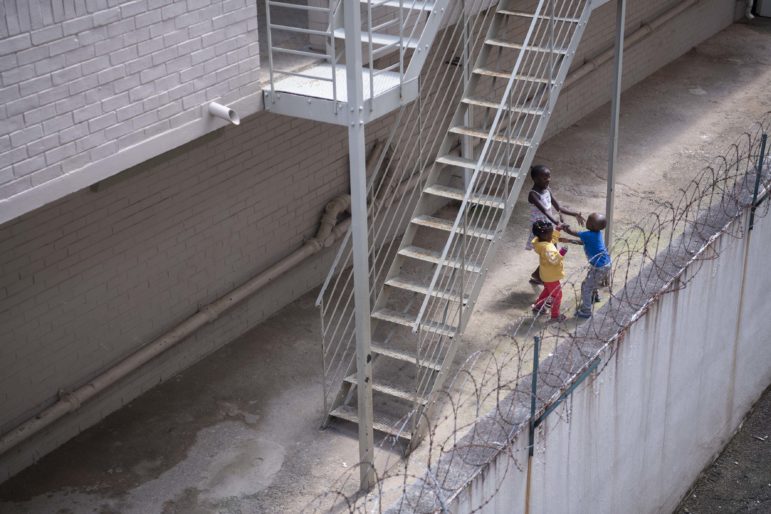
The children of domestic workers — unable to either go to school or return to their family homes — play in a concrete courtyard in Johannesburg. Photo: Madelene Cronjé
Then, on a formal assignment to cover a COVID-19 relocation program for homeless people, she discovered neglect, severe poverty, and extreme vulnerability to the virus at a different project nearby.
“I came across this emergency pandemic camp for homeless people at a place called Wembley — really nice, new army tents and facilities — but on the other side of this same field, there was another temporary place [called Wemmer Shelter] that the City of Johannesburg had set up three years ago, for people who had been evicted from hijacked buildings,” she said. “That place was so derelict and awful, with no sanitation or services, a bunch of people sleeping outside. Lots of criminality. And it was mostly migrants there being neglected. Nobody there had any sanitizer or masks, nobody had come to offer any help.”
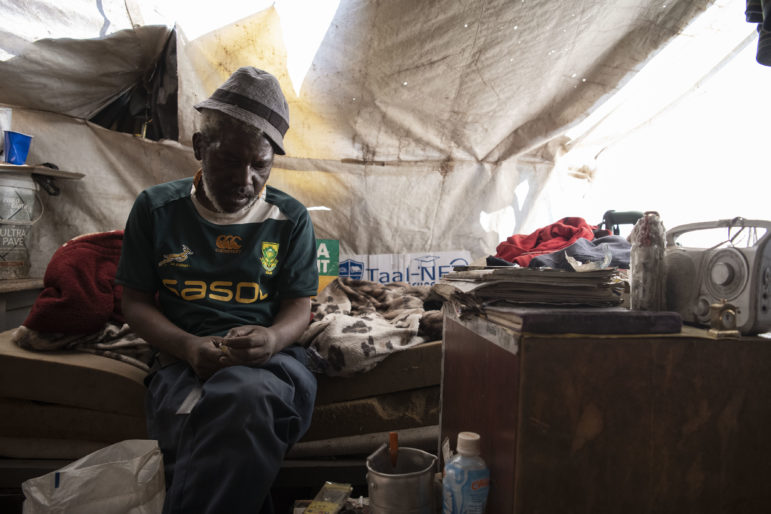
The building Yusuf Momba lived in burned down three years ago in Johannesburg, and then the relocation tent he lived in was burned down by arsonists. Now, Momba lives in Wemmer Shelter, a derelict government camp overlooked by city officials as they set up emergency COVID-19 relocation camps nearby. Photo: Madelene Cronjé
Cronjé contacted a charity organizer who then reached out to donors for help. Those donors supplied 400 blankets and about US$3,000-worth of food for those living in the derelict Wemmer camp.
Then Cronjé put her camera down, and began serving the residents at its soup kitchen, and kept at it twice a week for about four weeks.
“You’re supposed to be a journalist and impartial, but these people had nothing, winter’s coming, and there’s kids,” she says. “We ran the soup kitchen for a while, but then I decided we were getting a little too involved.”
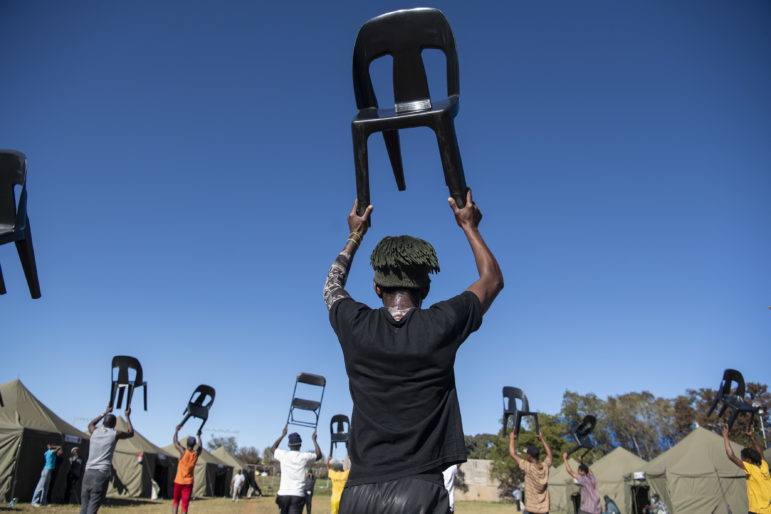
Homeless South Africans follow exercise instructions at the Turffontein Covid Camp — one of many shelters set up in Johannesburg to help slow down the pandemic spread. Photo: Madelene Cronjé
Pictures that Can Erode Stereotypes
In Washington, DC, Associated Press photographer Jacquelyn Martin focused on how COVID-19 was affecting hunger and grief in urban communities of color.
Operating from newsroom guidelines to avoid shooting indoors, Martin modified her approach, and, for instance, photographed a rabbi conducting a virtual prayer service through open double doors.
But, facing daily questioning about infection safety, she settled on a “uniform” for field assignments, and safety rituals on returning home.
“Any time I went on any assignment I would wear a mask and gloves,” says Martin. “I set up a regimen after each assignment — hand sanitizer, wipe down the cameras and computer with rubbing alcohol, shower once home, and wash my clothes immediately. A hard transition has been not being able to hug my young son when I return home before showering and changing. If I went to an assignment that was crowded, I would wear the N95 mask instead of a surgical [mask] and add eye protection to the mix. We are lucky that the AP has been really supportive.”
One powerful impact of Martin’s photojournalism has been to challenge certain racial stereotypes that have emerged during the pandemic, including the false belief that people of color were more vulnerable to the coronavirus because they were not taking steps to protect themselves from infection. “That’s not what I saw,” she says.
In May, she photographed a funeral — beautifully modified for COVID-19 safety — in this photo essay.
And, early in the pandemic — before even masks were being recommended by authorities — Martin captured the key image of a 12-year-old African American boy standing in line at a food donation center in southeast Washington, dressed by his mother in full hazmat gear.
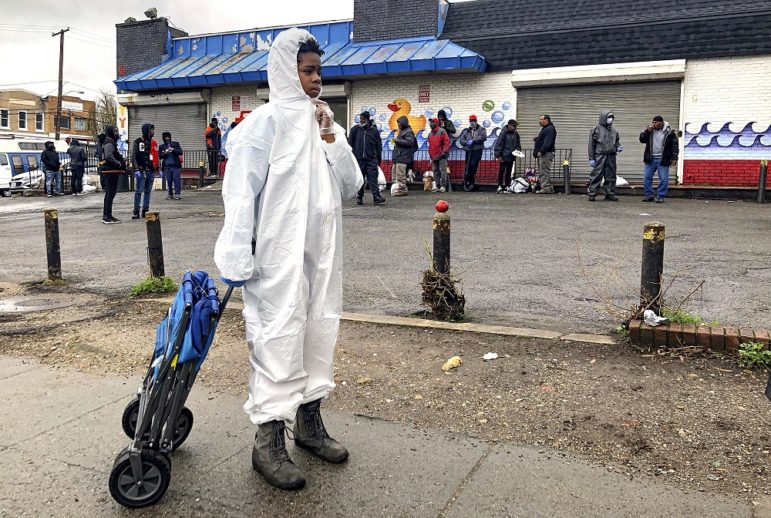
Cire Wilson, 12, waits in line at a food donation center in southeast Washington, DC, in March, wearing a protective suit. Image: AP Photo/ Jacquelyn Martin
“The statistics about deaths being higher in Black communities had not come out yet, but you could see people getting more concerned in real time,” says Martin. “The image of Cire is powerful because he is so young, and because he is the only person around him wearing that level of protective equipment. His mother wouldn’t let him leave the house unless he was fully protected. I feel like this image is a precursor to the pain the Black community was on the cusp of feeling. [COVID-19] has opened wide a view of the inequities in our country, and, as such, covering it is vitally important.”
Images as a Bridge
“The challenging thing for photographers in this pandemic is that access is so restricted,” says AP’s Goldman, referring to the Holyoke Soldiers’ Home project in which he projected images of veterans on relatives’ houses. “It was already difficult to photograph in hospitals and nursing homes before because of HIPAA [US health privacy regulations], and now it’s just become almost impossible. But I felt like I really wanted to do something,” he said.
Goldman reached out on Facebook to the “survived-by” relatives listed in obituaries, and found 12 families willing to participate.
“I thought about a portrait series of these veterans, but what also interested me was this thing about grieving in solitude,” he says. “So I wanted to combine those two elements.”
For the project to work visually, all 12 images needed a set of common features: an archive image of the deceased veteran in uniform, photographed while they were on active duty; shoots of the different houses timed to the same few minutes before dark; and relatives lit and visible at the windows.
Goldman says he learned moving and sometimes astonishing stories about the 12 deceased veterans as families dug through old photos and communicated with him by telephone.
For instance, he learned that Emilio DiPalma, 93, had dispensed quiet justice on one of Germany’s most notorious Nazis after World War II. Sent to Nuremberg to guard prisoners on trial for war crimes, DiPalma — a quiet and humble man — replaced the water in Hermann Göring’s cup with water from a toilet, after Göring complained about the drinking water. In a later interview, DiPalma recalled that Göring preferred the toilet water, “and I thought: Ha! – I gotcha babe.” Or about Francis Foley, 84, the soldier, carpenter, and devoted father-of-four who could play songs by ear, and who sent nurses home from work laughing.
Above all, Goldman learned that all 12 veterans had been towering figures in the lives of their families, and he was determined to show them that way.
When a generator didn’t work to power his projector, he bought a 100-foot power cable, and was relieved to find that all 12 family homes had outside plug points. Goldman then bought a simple clamp light from a superstore, wiped it with Clorox disinfectant, and instructed families on how to attach it to window frames.
“These family members almost became remote photo assistants to me, and they all did a terrific job — even moving furniture so they could get to the windows,” he says. “I’d never even operated a projector before. I had no idea what I was doing. But I knew I didn’t want to do portraits of people holding pictures of their loved ones.”
After each shoot, Goldman left the giant projected portraits on the house walls, and invited families to walk into their front yards and look.
“It was so moving because most of them came out and started crying,” he says. “They had never seen their father or mother that way. How they described it to me was that it gave them a bit of that send-off that they couldn’t have because of the pandemic. It was a cathartic way to finally have that memorial.”
Meanwhile, in Peru, Lucas was struggling to find a way to reflect both the overwhelming numbers of COVID-19 deaths, and the significance of each life lost.
He says the picture below was the closest he could get to representing both:
More About Reporting on COVID-19
Webinar Series: Investigating the Pandemic
How to Tackle the Global Undercount in COVID-19 Deaths: Reporters Offer Tips and Techniques
6 Tools and 6 Techniques Reporters Can Use to Unmask the Actors behind COVID-19 Disinformation
 Rowan Philp is a reporter for GIJN. Rowan was formerly chief reporter for South Africa’s Sunday Times. As a foreign correspondent, he has reported on news, politics, corruption, and conflict from more than two dozen countries around the world.
Rowan Philp is a reporter for GIJN. Rowan was formerly chief reporter for South Africa’s Sunday Times. As a foreign correspondent, he has reported on news, politics, corruption, and conflict from more than two dozen countries around the world.






